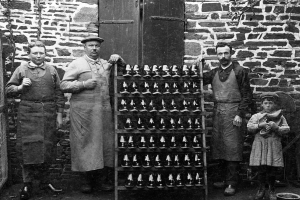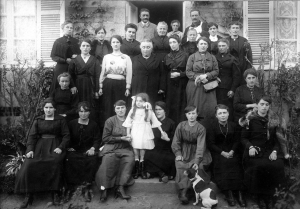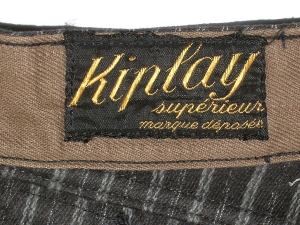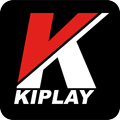History :Marcel letard was born on the 21st of October 1897 , in the town of Saint Pierre d’Entremont (61). He was the son of JB Letard, born in the same village on the 3rd January of 1867 ; and the son of d’Elise Robbe, born in fresnes in 1863.  Clog factory with Marcel and Jean Baptiste Letard (on left) Jean-Baptist had a factory of shoes in the village with 4 or 5 employees. During the first world war, Marcel is mobilized and sent to battle fields in the north. He is a victim of a bad infection but is supernaturally handed on feet and comes back strengthened by this terrible experience. In spite of being a primary school teacher, he prefers to develop the activity of his father. He meets in this time period Emilie Degasne, girl of François Degasne born on December 12th, 1858 and from Emilie Datin , born on May 26th, 1867.
 Workers and home workers of Emilie DATIN (in the middle) Marcel and Emilie get married on October 29th, 1921. During the First year of their union, they maintain both businesses of shoes and confection. The business of garments returns to Nazaire Degasne (the brother of Emilie). The real business of confection begins on February 1st, 1922 1. The garments mattresses were cut during meals at Léon Piard to benefit from electricity, and the cut pieces were distributed by Jean-Baptist Letard with a cart in order to deliver workers and bring back the whole piece. Emilie created the models and the couple decided to sell an activity, and it was done at the end of 1922 when Mister Letessier of Saint-Cornier bought the factory of shoes. He kept it several years before reselling it to Mister Moche from La-Ferté-Macé. The starting up really took place in 1925, when the company made its first profits and was composed of 11 employees, 31 workers and 4 salesmen. The first salesmen make their tours with bicycle. The made clothes were at the time working clothes in twill, clothes of hunting and clothes for farmers. in 1927 twenty machines working with electricity were Installed, resulting from an engine with naphthalene. Next year, about sixty employees worked for the company ,with two new salesmen. Marcel tries to diversify by working for auctions. His first market was taken for the estate management of Le Mans in 1933. Always in search of development, Marcel and Emilie leave to Paris to join their salesman Mister Wolf to show new prototypes of transport bags and gas masks. They meet Raymond Levy (father-in-law of Mister Wolf) who sees Marcel as a dynamic and hard-working man. Immediately and until the Second World War, Raymond Levy multiplies the meetings, having many relations, and takes numerous orders. He does not hesitate to call Marcel at 5 am in the morning and very late in the evening, and allows Marcel to develop at very high speed his business. It is fast necessary to open the other places, the first one is opened in Condé-sur-Noireau for the manufacturing of clothes for motorcyclists. In 1935, he opens a place in Saint James ( 50 ) and produces every day 1 500 gas masks and bags of transport and 500 clothes oiled in white cretonne. In 1938, Marcel opens two places in Flers for the manufacturing of military clothes (bags of transport and pilgrims anti-mustard gas, that is anti mustard gas). On July 21st, 1939, Marcel creates the Norman Company of confection (Sonorco) to avoid a surtax of the factories working for the national army. The head office is fixed in Flers with the board of directors composed of Marcel, Maurice Lelièvre, his guiding friend of Weavings and spinning of Flers, and Louis-Eugène Groult. October 16th, 36 people entered the company, then 26 on October 18th, 27 on October 20th, 26 October 27th, and 30 on October 30th, so 145 persons for the first month. In 8 months Marcel had hired 409 persons for Sonorco. With workforce in Saint-Pierre-d'Entremont and always workers at home, the couple employs in 1940 more than 900 persons. This figure shows the importance of the firm which was by far the first one of the region in its specialty. While all the shops produces day and night and supply the French army, the war arrives and all the employees are leaving the company between June 12th and June 16th, 1940, because of the arriving of the German army in the surroundings of Flers. Marcel suggests to 6 persons of Flers to come to work on Saint Pierre who does not close during the occupation and continues an slowed down activity in the confection of civil clothes. The estate management asks to Marcel to quickly install a clothing shop in the South of the Loire to supply them and save their stocks of garments. Marcel prepares sewing machines for the station of Flers where two trains must be given. But the confusion was such that they never arrived to Flers. The couple mobilizes all the family and the close relations, and move to Brillac in Charente in July, and the troop is made of around thirty persons. In front of the impossibility to find sewing machines, the return is organized in September 1940 At the end of the war, Marcel and Emilie notice bitterly that it is necessary to start again from scratch.. Stocks are plundered, Condé workshop is completely destroyed. Three factories of Flers are requisitioned. Only the units of Saint Pierre and Saint James are ready of start again. Saint James's factory resumes its activity in 1946 for the FNRC and the factory of Douets in 1947 for the estate management. In 1947, their son-in-law Paul Poulhès enters in the company and takes care of the accounting. In 1948, the son-in-law Roger Agati takes charge of relationships with the administrations. In 1951, their son Michel takes charge of the technique, then my father Hubert Pradal, a new son-in-law, becomes a sales manager. Marcel defines a strategy with strong personalities and install his son Michel in the head of Sonorco to work with the administrations. He places Hubert in the head of Letard Degasne, transformed in 1954 in a limited company, specialized in the civil clothes, working clothes and hunting. Whereas Michel, outstanding technician, develops organizations to improve the productivity, use patterns, and create the vitodo, which is the first Overall with double zip which since became a standard of the working cloth. Hubert is going to develop the turnover, and makes build in 1963 a new modern place of 1000 square meters in Saint Pierre.  Brand KIPLAY gold embroidered The succession is assured, Marcel dies on September 7th, 1968 in his 71th year, surrounded with the affection of his family and with the immense gratitude of the population of Saint-Pierre d'Entremont. After the years of big growing in the 1937s, 1938, 1939, on 1940, the years from 1969 till 1974 will be exceptional. Hubert opens a place in Sourdeval with the help of the municipality and builds a factory in 1976 to allow an increase of the workforce. The same year Letard Degasne acquires the Ball of the Weavings of Flers to transfer the factory of Douets which is flooded. In 2002, Letard Degasne will be called Kiplay, by the name of the trademark deposited in 1932. Extracted " from the textile industry in Normandy, XVIIth - Xxe siécle " Written by Marc Pradal, CEO of SAS Kiplay, Chairman of Normandy Clothing grand son of Marcel and Emilie Letard Son Of Hubert and Jeanne Pradal
|


